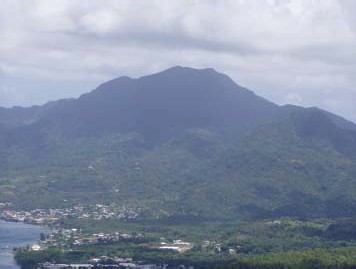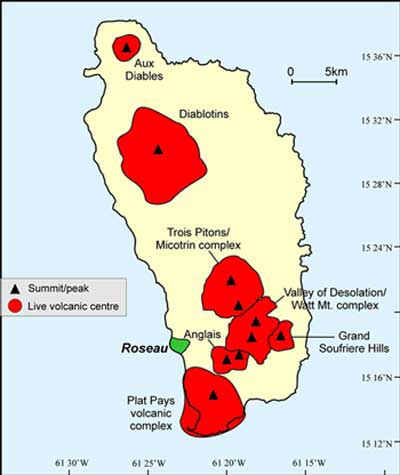Volume No. 2 Issue No. 13 - Monday September 17, 2007
The history and pictures of Dominica's volcanoes - Morne aux Diables
 By Thomson Fontaine By Thomson Fontaine

 Morne Aux Diables (Devil�s Peak) is one of the nine active volcanoes on Dominica, and one of only two in the Northern half of the island. Morne Aux Diables is not as tall as its closest neighbor Morne Diablotins (small or little devils) rising to only 2,826 feet/848 meters compared to Diablotin�s 4, 747 feet/1430 meters. Morne Aux Diables (Devil�s Peak) is one of the nine active volcanoes on Dominica, and one of only two in the Northern half of the island. Morne Aux Diables is not as tall as its closest neighbor Morne Diablotins (small or little devils) rising to only 2,826 feet/848 meters compared to Diablotin�s 4, 747 feet/1430 meters.
The relatively unknown Morne aux Diables stratovolcano forms the northern tip of the island of Dominica. The closest town to the volcano is Portsmouth and other villages close to the volcano include Thibaud, Pennville and Clifton.
Several nested craters and a 90-m-high, 335-m-wide lava dome are located within a larger 1.2-km-wide crater. A chain of lava domes, two of which form a peninsula on the SW flank, form an E-W belt across the southern flank of the volcano.
Morne aux Diables is dominantly composed of deposits of block and ash flows and associated domes from Pelean-style activity, however, semi-vesicular andesite block and ash flows and surges (Asama-style activity) and pumiceous lapilli falls (Plinian-style activity) are locally abundant.
No eruptions are known from Morne aux Diables in historical time, although the volcano has a youthful appearance and activity at flank domes likely continued into the late-Pleistocene and Holocene. Severe earthquake swarms in 1841 and 1893 were associated with either Morne aux Diables or Morne Diablotins to the south.
Age dating suggests that the main cone building activity occurred between 1.5 and 1.0 million years ago. Exposed on the volcano's flanks however are a number of unconsolidated valley-fill block and ash flow deposits suggesting more recent activity.
One of these deposits, on the north-east flank of the volcano, has been recently dated at less than 46,000 years B.P. Other evidence of potential activity from this center includes the presence of warm (27�C), acidic (pH 1.6), sulfate-rich springs on the summit of the volcano, and hot springs in the Portsmouth and Toucari areas.
In April of 2003, seismographs on the island recorded a swarm of over 500 earthquakes in the North of Dominica with the strongest recorded at 3.5 on the Reichter scale. However, scientists subsequently determined that the activity was not linked to any of the two volcanoes.
One year later, and in an effort to more closely monitor the volcano, the Seismic Research Unit of the University of the West Indies set up 8 monitoring stations in and around aux Diables.
 Nine of the Caribbean�s sixteen active volcanoes are located on the island of Dominica. By contrast there is one each on Guadeloupe, Martinique, St. Lucia, St. Vincent, Montserrat, Saba, St. Eustacius, St. Kitts, and Nevis. There are two in Grenada. Nine of the Caribbean�s sixteen active volcanoes are located on the island of Dominica. By contrast there is one each on Guadeloupe, Martinique, St. Lucia, St. Vincent, Montserrat, Saba, St. Eustacius, St. Kitts, and Nevis. There are two in Grenada.
Dominica�s nine active volcanoes are ; Morne au Diable, Morne Trois Pitons, Morne Diablotins, Morne Watts, Morne Anglais, Wotten Waven Caldera, Valley of Desolation, Grande Soufriere Hills and Morne Plat Pays.
The youngest dated volcanic deposits on the island are associated with the Morne Patates dome on the flanks of the large active Plat Pays Volcano that comprises the southwestern end of the island. This was a Pelean eruption (similar to the eruptions of Mt. Pelee on Martinique in 1902 and 1929) and radiocarbon ages from the block and ash deposits suggest it occurred about 500 year ago.
In addition there have been two steam explosions (phreatic activity) in the Valley of Desolation in 1880 and 1997. Frequent seismic swarms and vigorous and widespread geothermal activity today characterize the island. In fact it is the most worrying of all the Caribbean volcanic areas and there is a general feeling that it (like Montserrat pre-1995) is long overdue for an eruption. Scientists are predicting that there will be at least one major eruption within the next 100 years.
What is of particular concern is that the capital Roseau and most of the islands infrastructure lie on a pyroclastic flow fan derived from the Wotten Waven caldera situated on the eastern outskirts of the capital.
The pyroclastic deposits of the Roseau area abound with ignimbrites (pumiceous pyroclastic flows), surge and airfall deposits with radiocaron ages ranging from 38,000 to 1000 years B.P.
Volcanologist Haraldur Sigurdsson as long ago as 1972 described one of the units which he called the Roseau ash and together with other workers traced its submarine extension. As a result of this work they concluded that about 38,000 years ago the island erupted around 56 cubic kilometers of pumiceous materials in what was described as the largest eruption in past 200,000 years in the Caribbean.
Pyroclastic flows deposited about 30 cubic km on the Caribbean floor and the remainder was deposited on the Atlantic floor from AntiTrade Wind dispersal. More recent work suggests that there are several ignimbrite sheets separated by ancient soils and the deposits may have resulted from several eruptions. However all conclusions indicate that the capital Roseau is situated in one of the most hazardous areas of the island.
The Dominican.net will continue to bring you the history and photos of this aspect of our beautiful island over the next several issues.
Related Articles
The History of a Volcanic Island
The Morne Plat Pays (Flat Footed) Volcano
The Morne Watt (Rat Mountain) Volcano
The Morne Diablotins (little devils) Volcano
Dominica Eco Trip
Dominica Treasure Island
The following references are the sources used in writing the articles on Dominica�s volcanos: (i) Bellon H, 1988. Reconnaissance chronologique des deux premieres phases d'activite volcanique en Dominique (Petites Antilles). Compte Rendus Acad Sci Paris, 306: 1487-1492;
(ii)Lindsay J M, Smith A L, Roobol M J, Stasiuk M V, 2005b. Dominica. In: Lindsay J M, Robertson R E A, Shepherd J B, Ali S (eds). Volcanic Hazard Atlas of the Lesser Antilles, Trinidad and Tobago, Seismic Res Unit, Univ West Indies, p 1-47;
(iii) Robson G R, Tomblin J, 1966. West Indies. Catalog of Active Volcanoes of the World and Solfatara Fields, Rome: IAVCEI, 20: 1-56;(iv)Shepherd J B, 1989. Eruptions, eruption precursors and related phenomena in the Lesser Antilles. In: Latter J H (ed), Volcanic Hazards - Assessment and Monitoring, Berlin: Springer-Verlag, p 292-311;
(iv) Shepherd J B, 2001. Volcanoes of the eastern Caribbean: past activity and future hazards. Paper presented at the Workshop on Volcanic and Seismic Hazards in the eastern Caribbean, May 28- June 1, 2001, 57 p; and
(v) The Smithsonian Institute Website http://volcano.si.edu.
|
|





